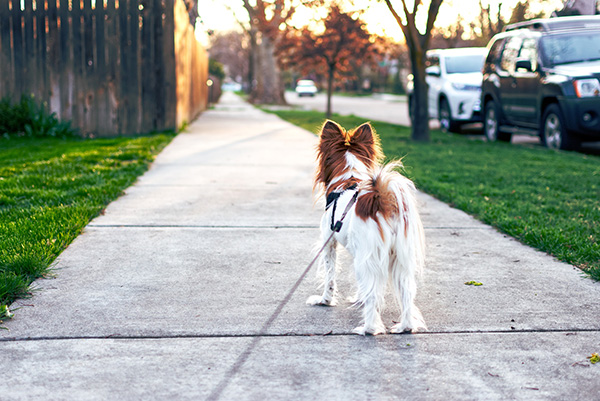-
Home
-
Shop
New -
Explore
-
Support
-
Track Order
Dec 20, 2022
Author:Lisa Martinez
Smaller dogs might benefit from just one daily stroll, but high-energy dog types will need multiple walks. Perhaps you are just not sure of how much exercise your dog needs. Take a trip to your vet in this situation. They will offer you some great hints and guidance according to the particular conditions involving your dog. Or you can try to use the tips given below to find out about it.
Let’s start by looking at the breed of dog you have. Dogs bred to be lapdogs, such as Papillons and Yorkshire Terriers, may have lower exercise needs than sporting or working breeds, like Collies, Pointers, and Shepherds.
Some dogs are born athletes, while others enjoy spending most of their time lounging around. Of course, a dog’s breed may play a role in this or it may simply be the dog’s own choice.

When your dog is just a pup it is important to protect its joints by taking them on smaller walks. As they grow older their need for staying active increases with it as well. If you have a middle-aged dog, try walking them 3 to 4 times a day apart from their poop break. When your dog goes into old age, it will need less exercise so a walk or two a day will do its trick.

Most of the dogs that are in good physical condition can go on 20-30 minutes walks without any trouble. Some can even go up to two hours of hiking or more. However, if you have a big dog that is overweight or obese can hardly walk for 10 minutes without breaks, or is uninterested.
Based on your dog’s size, determine how long of a walk your dog should have. Notice your dog’s behavior when you return. If he is slowing down then he could be tired and you need to take shorter walks.

An additional consideration with elderly dogs is the possibility of illnesses like diabetes or arthritis. These might contribute to individuals having less endurance and being less motivated to exercise and take walks. See if they are limping when you get home or going to their dog beds and staying there for hours, it’s a tell-tale sign your dog needs a vet visit.
Look at your dog, no really, look at him! Does he look like a ball of energy or a slump-down one? Match your dog’s personality to its walk limits. If your dog is high on energy, he needs to be taken out more frequently. If he likes to lounge around most of the day, a walk a day would be fine for them.
There is no exact time that one can determine your dog walks for you. Start with a 30-minute walk if you have a healthy dog then increase it with time. It is recommended to take 30 minutes to 120 minutes of walking each day or take another one during the day. Most adult dogs need to work out their energy by taking frequent walks. Understand that these walks don’t mean bowel requirements.
If you feel like your dog still has quite a lot of energy after walks maybe try to add more energetic things on your stroll. Play fetch with other dogs or take your buddy to the nearest doggie playgrounds. If you have way too much to do on your hand consider hiring a dog walker for regular exercise. As you may not know but keeping the dog inside raises levels of anxiety in them. Not only this, but it can also adversely affect your bond with your pawed friend.

We get it you want to give your puppy a way to burn off some energy. By the time they are 16 weeks old, when the majority of puppies finish their vaccines, they are healthy enough to interact with other animals. Limit the number of unfamiliar canines your puppy interacts with in the interim.
On the other side of the spectrum, older dogs can develop arthritis and other musculoskeletal issues, which can hurt your dog’s bones and muscles. If you notice a certain agitation in your dog while walking, it’s time to take him to the vet.

You can keep up a comfortable and steady pace when walking your dog. For most dogs, the average pace is 25 minutes per mile. Dogs with shorter legs may need a slower pace, while dogs with longer legs may need a faster pace than walkers.
You won’t be able to carry pups or older dogs very far because they have less energy than adult dogs and need to go potty every two to four hours, so you’ll need to take them out more regularly. Begin modestly by pacing your puppy back and forth in front of the home, then progress from there.

The ideal time for taking your dog for a walk should be the same every day, so planning ahead can be quite helpful. You may arrange the rest of your life around this by setting alarms, etc. if you know that you will be taking them twice a day at 7 a.m. and 7 p.m. This will help your dog become accustomed to the routine and will be ready when the time comes.
Dogs struggle to control their body temperatures, so you should consider the weather before taking them for a walk outside. Doctors advise against walking a dog on hot asphalt if you get one in the summer. Winter weather is the same. When the weather drops, try to keep your dog indoors and make sure they have cozy things to keep them warm. This goes beyond quick potty breaks.
Popular Post

Why Does My Cat Cough After Drinking Water? 8 Potential Reasons
Mar 13, 2023

My Cat Only Eats A Little at A Time - What to Do?
Feb 27, 2023

What to Feed a Sick Dog With No Appetite? [2024 Guide]
May 16, 2023

Why Is My Dog Being Destructive All of A Sudden?
Feb 04, 2023

Do Puppies Miss Their Moms
Feb 11, 2023
Copyright © 2024 WOPET. All Rights Reserved.